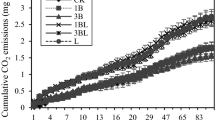Abstract
The dynamics of culturable chitin-degrading microorganisms were studied during a 16-week incubation of chitin-amended coastal dune soils that differed in acidity. Soil samples were incubated at normal (5% w/w) and high (15% w/w) moisture levels. More than half of the added chitin was decomposed within 4 weeks of incubation in most soils. This rapid degradation was most likely due to fast-growing chitinolytic fungi (mainly Mortierella spp. and Fusarium spp.) at both moisture levels, as dense hyphal networks of these fungi were observed during the first 4 weeks of incubation. Chitin N mineralization was inhibited by cycloheximide, and fast-growing fungal isolates were capable of rapid chitin decomposition in sterile sand, further suggesting that these fungi play an important role in initial chitin degradation. The strong increase in fast-growing fungi in chitin-amended dune soils was only detected by direct observation. Plate counts and microscopic quantification of stained hyphae failed to reveal such an increase. During the first part of the incubation, numbers of unicellular chitinolytic bacteria also increased, but their contribution to chitin degradation was indicated to be of minor importance. During prolonged incubation, colony forming units (CFU) of chitinolytic streptomycetes and/or slow-growing fungi increased strongly in several soils, especially at the 5% moisture level. Hence, the general trend observed was a succession from fast-growing fungi and unicellular bacteria to actinomycetes and slow-growing fungi. Yet, the composition of chitinolytic CFU over time differed strongly between chitin-amended dune soils, and also between the two moisture levels. These differences could not be attributed to pH, organic matter or initial microbial composition. The possible consequence of such unpredictable variation in microbial community composition for the use of chitin-amendments as a biocontrol measure is discussed.
Similar content being viewed by others
Author information
Authors and Affiliations
Additional information
Received: 10 March 1998
Rights and permissions
About this article
Cite this article
De Boer, W., Gerards, S., Klein Gunnewiek, P. et al. Response of the chitinolytic microbial community to chitin amendments of dune soils. Biol Fertil Soils 29, 170–177 (1999). https://doi.org/10.1007/s003740050541
Issue Date:
DOI: https://doi.org/10.1007/s003740050541




